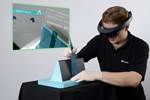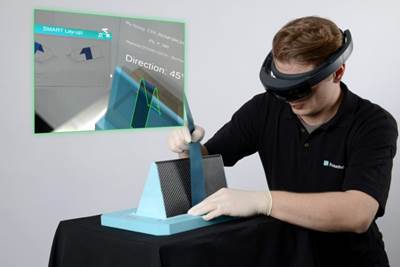Advanced Composites Training uses augmented reality to deliver composites training
Virtual system delivers live composite technology training courses for a range of industries without the inconvenience of travel.

ACT founder Wilson Boynton uses augmented reality to deliver composites training. Photo Credit: ACT
The COVID-19 global pandemic has forced many businesses to find new ways of delivering their goods and services. For Advanced Composites Training (ACT, London, Ontario, Canada), a division of Renaissance Aeronautics Associates (RAA) Inc., that meant developing and launching a new augmented reality system to deliver composites training. Using Microsoft HoloLens2 and software developed by Kognitiv Spark (Brunswick, Canada), ACT is able to offer live courses to students globally.
ACT founder, Wilson Boynton, believes his company is the first to use augmented reality to deliver intensive composites technology training for the aerospace, aviation, automotive, marine and renewable energy industries.
“This is a huge benefit to our clients who are considered essential workers worldwide, but who may not be able to come to London due to travel and quarantine restrictions,” says Boynton. “It also allows us to increase our class sizes, since physical distancing is not a factor.” As the only privately-owned Canadian composites training institute exceeding both Transport Canada and American Federal Aviation Administration standards, ACT works with both civilian and military technicians from more than 39 countries.
ACT offers 17 courses covering all aspects of composites manufacturing and structural repair technologies. According to the company, technicians typically travel to London, Canada for intense on-site training, which combines a mix of theory and hands-on instruction.
However, demand for composites training has remained strong since the beginning of the pandemic, says Boynton, prompting the decision to explore virtual training options. “Augmented reality allows us to project holograms that the instructor sees through the HoloLens,” he says. Students tune in from their laptop or other digital device. “They see exactly what the instructor sees. It’s like having someone looking through your eyes while you are doing the work.”
Reaction to ACT’s augmented reality training has been positive. “Clients are very satisfied,” says Boynton. “Students get the experience of being here, without having to travel.” The launch of augmented reality training is the latest in a number of exciting milestones for ACT.
This February, Boynton enjoyed the thrill of watching NASA’s Perseverance rover land on Mars. Less than two years ago, he was invited to NASA’s Jet Propulsion Laboratory (JPL, Pasadena, Calif., U.S.) to provide training in the composite materials used in its construction. “Composites made the whole thing possible,” he notes.
April 2021, ACT also celebrates 25 years in business. The company plans to celebrate with a 25th Anniversary Virtual Open House on May 11, 2021. “People can take a virtual tour of our facility through the use of the HoloLens and learn more about our training options,” Boynton says.
While augmented reality training will continue to allow technicians from around the world to strengthen their composites knowledge without the inconvenience of travel — long after the global pandemic is over — Boynton believes it will never completely replace the in-class experience.
“Technicians are tactile learners,” he says. “Augmented reality training is an effective way to deliver the vast majority of the knowledge people need to be comfortable working with composites, but it will never completely replace hands-on learning.”
Related Content
How AI is improving composites operations and factory sustainability
Workforce pain points and various logistical challenges are putting operations resilience and flexibility to the test, but Industry 4.0 advancements could be the key to composites manufacturers’ transformation.
Read MorePlant tour: Sekisui Aerospace, Orange City, Iowa, Renton and Sumner, Wash., U.S.
Veteran composites sites use kaizen and innovation culture to expand thermoplastic serial production, 4.0 digitization and new technology for diversified new markets.
Read MoreNew Frontier Technologies launches digital twinning, high-fidelity simulation capability
3D imaging and analysis capability illustrates detailed, quality characterization and performance simulation of composites and other advanced materials that properly captures the as-manufactured component.
Read MoreST Engineering MRAS presents initiatives to drive autoclave efficiency, automation
During a JEC World 2024 panel discussion, the company revealed ways in which it is maximizing throughput and efficiency of its autoclaves and enhancing composites production processes.
Read MoreRead Next
Augmented reality system facilitates FRP component preforming
The software makes exact alignment and position of materials directly visible on the component.
Read MoreDeveloping bonded composite repair for ships, offshore units
Bureau Veritas and industry partners issue guidelines and pave the way for certification via StrengthBond Offshore project.
Read MorePlant tour: Daher Shap’in TechCenter and composites production plant, Saint-Aignan-de-Grandlieu, France
Co-located R&D and production advance OOA thermosets, thermoplastics, welding, recycling and digital technologies for faster processing and certification of lighter, more sustainable composites.
Read More
























